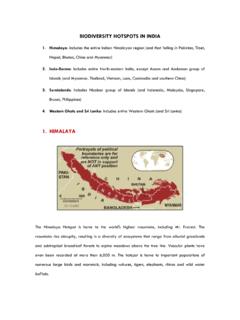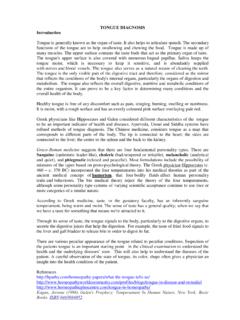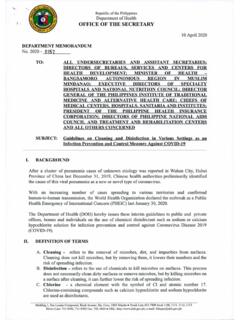Transcription of Complete Herbal Medicine Guide - Home Remedies Log
1 Complete Herbal Medicine Guide Complete Herbal Medicine Guide By Complete Herbal Medicine Guide Disclaimer and Legal Notices While all attempts have been made to verify information provided in this publication, the publisher assumes no responsibility for errors, omissions, or contrary interpretations of the subject matter contained herein. The publication is produced for entertainment purposes only and is not intended for use as a source of any advice such as legal, medical, or therapeutic. The publisher wishes to stress that the information contained herein may be subject to varying international, federal, state and/or local laws or regulations. The purchaser or reader of this publication assumes all responsibility for the use of these materials and information. Adherence to all applicable laws and regulations, including international, federal, state and local, governing all aspects of life in any jurisdiction is the sole responsibility of the purchaser or reader.
2 Neither the author nor the publisher assume any responsibility or liability whatsoever on behalf of any purchaser or reader of these materials. Any perceived slight of any person or organization is completely unintentional. By 2 Complete Herbal Medicine Guide Table of Contents 1. The History Of Herbs 2. Your Own Herb Garden 3. Harvesting And Storing Your Herbs Drying Herbs Freezing Herbs 4. Cooking With Herbs 5. Medicinal Properties of Herbs Preparation Of Remedies Remedial Properties Of Each Herb Agnus Castus Aloe Vera Arnica Anise Basil Black Cohosh Borage Buchu Leaf Caraway Cayenne Celery Celery Seed Chamomile Flowers Chickweed Chicory Cilantro Cinnamon By 3 Complete Herbal Medicine Guide Clove Comfrey Cramp Bark Damiana Dandelion Devil's Claw Dill Echinacea Root Fennel Fenugreek Feverfew Garlic Ginger Gingko Leaf Ginseng Golden Seal Hawthorn Berry Horseradish Hyssop Lavender Lemon Balm Licorice Lime Flower Marigold Milk Thistle Mint Mustard Nutmeg Oregano Parsley Passiflora By 4 Complete Herbal Medicine Guide Raspberry Leaf Red Clover Rosemary Sage Slippery Elm St John's Wort Tarragon Tea Tree Thyme Tumeric Valerian Vervain Willow Bark Witch Hazel Yarrow 6.
3 In Conclusion By 5 Complete Herbal Medicine Guide 1. The History Of Herbs What is a herb? The dictionary says: a plant whose stem is not woody, which dies down to the ground after flowering; a plant whose leaves etc are used for food, Medicine , scent or flavor. Herbs have been used since the dawn of the human race. Even before people began to cook on fires, herbs were probably being harvested and used raw for food or medicinal purposes. Native Americans, Aboriginal Australians and many other peoples following an undeveloped way of life all use herbs extensively. There was a herb for almost every ailment or need. Sometimes they were used in witchcraft too, although the dividing line between witchcraft and Medicine was often blurred, as in the example of the witch doctor . Originally, people had no understanding of the causes of disease such as bacteria, viruses, etc. They believed sickness was caused by supernatural forces, either evil spirits or spells placed by other people.
4 Therefore, a person who knew how to cure sickness was believed to be dealing with evil spirits and practicing magic. This association persisted even after people began to understand the biological causes of disease. In Europe many people who were branded as witches were probably simple Herbal Medicine practitioners. Herbal Medicine was outlawed in many of these countries by governments influenced by the new scientific and male-dominated form of Medicine . Herbs, along with spices, were valuable commodities in trade in former times. From around 114 BC until 1400 AD, the silk road was used to trade herbs and spices between Europe and Asia. Europeans imported ginger, cinnamon and other spices, and exported herbs like sage that were much in demand in Asia for their aromatic and medicinal By 6 Complete Herbal Medicine Guide properties. This kind of trading led to communication between civilizations that could be said to form the basis of the world culture of today.
5 chinese traditional Medicine is still today based mainly on the use of herbs, but in Western culture they did not start to make a serious comeback for any purpose other than cooking until the 1960s and 1970s, when cultural and ecological movements started to consider adopting the best features of pre-industrial society in our postindustrial age. Most of the well known herbs can easily be grown in a garden. Because they are mostly small plants, even a very small garden such as a roof garden is sufficient. Herbs are ancient, natural plants that grew wild, so they are hardy and resistant to disease when grown in a soil and climate that is similar to their native region. Many of them can also be grown indoors. Of course they are also used to flavor dishes in cooking. Some dishes and sauces such as pesto and mint sauce are based around one particular herb. Others, like pumpkin pie and sausages, get most of their individual flavoring from the blend of herbs that is used.
6 Herbs have been in our lives, our homes, our gardens and especially in our kitchens, forever! 2. Your Own Herb Garden Many of us have childhood memories of playing in a garden on a sunny day with the scent of lavender, rosemary and mint accompanying our every step. Just a whiff of these scents will bring a wave of nostalgia for childhood summers, fairy tales and times gone by. The good news is that we can create our own fairy tale setting right here and now by planting a herb garden in even the smallest back yard. By 7 Complete Herbal Medicine Guide Herbs are natural weeds or wild plants and unlike many flowering plants they have not been bred or mutated into something more pleasing to the eye. They remain in their original state and as such they are most often hardy and easy to grow with a natural resistance to disease. You can avoid using chemical pesticides on them and if you can do the same with the rest of your garden, you will have organic herbs that you can safely eat when any superficial dust and insect matter have been washed away.
7 The location of your herbs is important. They need to be close to the house where you will constantly see them. Under the kitchen window is great. This way, you will remember to water them and you will not have far to go when you need a little flavoring in the middle of cooking dinner. Even if it is raining, just a step outside and you will have your herbs. If they are at the far end of the garden, on the other hand, they are more likely to be neglected and unused. Many herbs are small plants that do not require much space, but beware of them spreading uncontrollably. Lavender can become huge hedges, mint can pop up all over your lawn, and many others will simply grow and grow if they are happy in your garden. Give them plenty of space and be prepared to control them firmly when necessary. Your first decision will be whether to grow your herbs all together or mix them around the garden with other plants.
8 There is a lot to be said for having all your herbs within easy reach in one bed, and if you do this be sure not to make the bed narrow enough that you can harvest the leaves you need without damaging other plants. On the other hand, plants in the wild tend to grow with certain other companion plants and if you mimic this by considering compatibility in planting your herbs, all of your garden may benefit. Here are some examples: - Parsley, tomatoes and asparagus is a good combination. Parsley also grows well with lettuce. By 8 Complete Herbal Medicine Guide - Sage and tarragon are said to grow so well together that you will have a more intense flavor from both herbs if you mix them rather than keeping each separate. - Dill does well with cucumbers. However, do not try to grow dill with potatoes or cabbage, as they are incompatible. Many herbs have other helpful properties. Nasturtiums are good next to fruit trees to keep aphids away.
9 Lavender does the same for roses. Thyme along the edge of a bed will help to deter snails. Marigold and borage provide saponins, important nutrients for the soil. Herbs are not all leaf. Sage, lavender, borage, feverfew, chamomile and marigold are all examples of herbs which will flower beautifully in your garden. If you have plenty of space, you may want to plant more of these than you need, because they are so attractive. Of course, you will want to plant smaller growing herbs at the front of any bed with larger plants behind, both for ease of reach and for a better display. Most herbs enjoy a sunny spot although there are exceptions. However, it is better not to have them in full sun all day, or they will mature and turn to seed very quickly. Once they are forming seeds, all of their goodness and energy goes into the seed so unless your aim is to produce seeds ( with coriander or pepper) you should take your main harvest before that happens, while the flavor and nutrients are still in the leaf (or flowers, with chamomile).
10 Of course you can also grow herbs in containers. Many will thrive in a small container. Some, like mint, can be grown in pots buried into the soil to prevent them spreading uncontrollably. Others grow so well in pots that containers have been designed specifically for them you can grow parsley in a special clay parsley pot , if you wish. If you use wooden containers, be sure they have not been treated with any damaging chemicals. Anything used in the treatment will enter the soil, be taken into the plant and By 9 Complete Herbal Medicine Guide eventually end up in your stomach, so it is worth taking some care with this. If you want to grow your herbs organically you may prefer to use clay pots. Be sure that the containers are well drained, because most herbs like a fairly dry environment. This means having drainage holes on the underside of the pot, and also placing a layer of large gravel or similar before you add any soil, to help with drainage.




